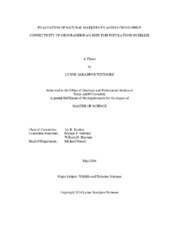| dc.description.abstract | Quantitative evaluations of early-life connectivity in reef fish populations are critical to the effective identification and management of productive nearshore nurseries. The present study evaluates the use of natural markers in assessing both trophic and population connectivity for three species of snappers (Lutjanidae) utilizing back-reef nurseries in southern Belize: dog snapper (Lutjanus jocu), gray snapper (L. griseus), and schoolmaster (L. apodus). Juvenile snappers were collected from inner- and outer-shelf nurseries across two latitudinal regions in the Belize coastal lagoon in order to: (a) utilize tissue stable isotopes (δ^(13)C and δ^(15)N) as dietary tracers to characterize organic matter production across the continental shelf, and (b) evaluate the utility of otolith stable isotopes (δ^(13)C and δ^(18)O) as a marker of nursery origin.
Isosource models (based on tissue δ^(13)C and δ^(15)N) revealed distinct differences in food web dynamics between pristine nurseries and those influenced by heavily impacted watersheds. Juvenile snappers at pristine sites were supported by organic matter derived from both benthic sources (seagrass/benthic diatoms) and the water column (phytoplankton), while sites impacted by anthropogenic runoff displayed significant decreases in water column-based production during the rainy season, accompanied by significantly decreased juvenile snapper condition (muscle lipid content) for all three species. These results emphasize the high land-sea connectivity in this system and indicate that runoff from impacted watersheds has the potential to disrupt trophic production in nurseries across the continental shelf.
Otolith stable isotopes (δ^(13)C and δ^(18)O) appeared to be strongly related to salinity gradients within the Belize coastal lagoon and, consequently, showed considerable promise in identifying juvenile snappers to shelf position. Both isotopes were both consistently enriched in snappers from outer-shelf nurseries, where freshwater influence was minimal, and δ^(18)O was enriched in the northern sampling region, which receives lower amounts of freshwater input compared to the south. Although individuals of each species were classified to specific study sites with varying success (58-81%), discrimination to shelf position was consistently high for all species (74-92%), indicating that otolith δ^(13)C and δ^(18)O may be useful in determining relative contribution rates of juvenile snappers produced at inner- and outer-shelf nurseries within tropical back-reef systems. | en |


